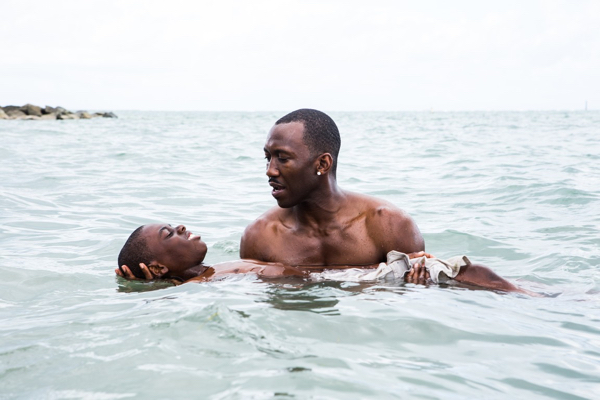Movie review by Greg Carlson
Admirers of Barry Jenkins’ excellent 2008 feature “Medicine for Melancholy” waited years for the filmmaker’s next project. “Moonlight,” one of 2016’s finest films, was worth that lengthy silence. In between the two movies, Jenkins made a handful of shorts and directed an episode of a TV series, but one viewing of “Moonlight” will convince anyone who loves the cinema that the prodigiously talented artist should keep telling long-form stories. Inspired by Tarell Alvin McRaney’s “In Moonlight Black Boys Look Blue,” Jenkins shares the story of a young man growing through adolescence to adulthood, lighting the journey with a dazzling command of moviemaking skill and a genuinely moving sense of humanity.
Presented in triptych and featuring different performers for each stage of protagonist Chiron’s maturation, “Moonlight” unfolds chronologically, beginning with Alex Hibbert’s bullied, nearly mute grade-schooler, dubbed Little for both his physical size and his practiced invisibility. Little’s mother Paula (Naomie Harris), addicted to crack, cannot provide any comfort and stability to her son, so he often finds himself in the care of drug dealer Juan (Mahershala Ali) and Juan’s partner Teresa (Janelle Monae). “Moonlight” is saturated with stunning performances, but Ali is impossible to forget. In what could be the most perfect, most beautiful scene this year, Juan teaches Little to swim, gently buoying and cradling the child in the waters of the Atlantic.
That patient, powerful baptism connects a symbolic son to a symbolic father in ways that ripple through the complexities of their relationship: Juan is Paula’s dealer. Ali’s presence is missed in the subsequent sections of the film, but Jenkins’ turn to the emerging sexuality of teenage Chiron (Ashton Sanders) is no less ambitious than the accomplishments of the first act. In an essential essay, Adam Shatz writes that “Moonlight” “is a film about the varieties of love that emerge in conditions of urban violence, not the varieties of violence that, as Baldwin suggested, have conditioned, and even prevented, the expression of black love.” It is the intersection of love and violence – in proximity through Chiron’s relentlessly homophobic classmates – that is the fulcrum of “Moonlight.”
In the film’s final section, Chiron is reborn as Black (Trevante Rhodes), a chiseled, muscular loner whose post-incarceration vocation selling drugs echoes Little’s childhood connection to Juan. Linked more overtly to Chiron’s memories of his first significant sexual experience with his friend Kevin (played as a grown-up by Andre Holland), the film’s concluding chapter is a miniature masterpiece of interpersonal vulnerability, revelation, and self-disclosure. Jenkins resists neat answers with a deliberate ambiguity that leaves plenty of room for something like hope, or as the filmmaker has suggested, something like healing.
Reviewers often praise cinematographers whose craft stands out in the execution of a great film, but the names of color graders rarely make it to print. Jenkins worked closely with director of photography James Laxton and digital intermediate colorist Alex Bickel on the look of “Moonlight,” and the bold choices expressed in their collaboration demand recognition. An “Indiewire” article by Chris O’Falt details the strategies for expressing the “beautiful nightmare” of the film’s Miami setting. In keeping with the triple-casting/triple-division elements of the story, each segment emulates a different film stock (Fuji, Agfa, and a modified Kodak), and the technique pays off with an absolutely stunning palette that embraces the dreamlike subjectivity of Laxton’s prowling, mobile camera.
“Moonlight” is as much an auditory feast as a visual one. From the emphatic opening choice of Boris Gardiner’s “Every Nigger Is a Star” to the perfect placement of Barbara Lewis’ aching “Hello Stranger,” the music of “Moonlight” comes to life as another of the movie’s indispensable characters. In addition to the most soaring cinematic application of Caetano Veloso’s “Cucurrucucu Paloma” since Pedro Almodovar absolutely owned it in “Talk to Her,” “Moonlight” has a diamond in composer Nicholas Britell. Britell’s cues are an ideal complement to the story Jenkins tells so intimately, so urgently, so bracingly, and so hauntingly.
